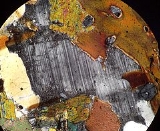
Plagioclase
Overview
Plagioclase is an important series of tectosilicate
mineral
s within the feldspar
family. Rather than referring to a particular mineral with a specific chemical composition, plagioclase is a solid solution
series, more properly known as the plagioclase feldspar series (from the Greek "oblique fracture", in reference to its two cleavage
angles). This was first shown by the German mineralogist Johann Friedrich Christian Hessel (1796–1872)
in 1826. The series ranges from albite
to anorthite
endmember
s (with respective compositions NaAlSi3O8 to CaAl2Si2O8), where sodium
and calcium
atoms can substitute for each other in the mineral's crystal lattice
structure.
Silicate minerals
The silicate minerals make up the largest and most important class of rock-forming minerals, constituting approximately 90 percent of the crust of the Earth. They are classified based on the structure of their silicate group...
mineral
Mineral
A mineral is a naturally occurring solid chemical substance formed through biogeochemical processes, having characteristic chemical composition, highly ordered atomic structure, and specific physical properties. By comparison, a rock is an aggregate of minerals and/or mineraloids and does not...
s within the feldspar
Feldspar
Feldspars are a group of rock-forming tectosilicate minerals which make up as much as 60% of the Earth's crust....
family. Rather than referring to a particular mineral with a specific chemical composition, plagioclase is a solid solution
Solid solution
A solid solution is a solid-state solution of one or more solutes in a solvent. Such a mixture is considered a solution rather than a compound when the crystal structure of the solvent remains unchanged by addition of the solutes, and when the mixture remains in a single homogeneous phase...
series, more properly known as the plagioclase feldspar series (from the Greek "oblique fracture", in reference to its two cleavage
Cleavage (crystal)
Cleavage, in mineralogy, is the tendency of crystalline materials to split along definite crystallographic structural planes. These planes of relative weakness are a result of the regular locations of atoms and ions in the crystal, which create smooth repeating surfaces that are visible both in the...
angles). This was first shown by the German mineralogist Johann Friedrich Christian Hessel (1796–1872)
Johann F. C. Hessel
Johann Friedrich Christian Hessel was a German physician and professor of mineralogy at the University of Marburg....
in 1826. The series ranges from albite
Albite
Albite is a plagioclase feldspar mineral. It is the sodium endmember of the plagioclase solid solution series. As such it represents a plagioclase with less than 10% anorthite content. The pure albite endmember has the formula NaAlSi3O8. It is a tectosilicate. Its color is usually pure white, hence...
to anorthite
Anorthite
Anorthite is the calcium endmember of plagioclase feldspar. Plagioclase is an abundant mineral in the Earth's crust. The formula of pure anorthite is CaAl2Si2O8.-Mineralogy :...
endmember
Endmember (mineralogy)
An endmember in mineralogy is a mineral that is at the extreme end of a mineral series in terms of purity. Minerals often can be described as solid solutions with varying compositions of some chemical elements, rather than as substances with an exact chemical formula...
s (with respective compositions NaAlSi3O8 to CaAl2Si2O8), where sodium
Sodium
Sodium is a chemical element with the symbol Na and atomic number 11. It is a soft, silvery-white, highly reactive metal and is a member of the alkali metals; its only stable isotope is 23Na. It is an abundant element that exists in numerous minerals, most commonly as sodium chloride...
and calcium
Calcium
Calcium is the chemical element with the symbol Ca and atomic number 20. It has an atomic mass of 40.078 amu. Calcium is a soft gray alkaline earth metal, and is the fifth-most-abundant element by mass in the Earth's crust...
atoms can substitute for each other in the mineral's crystal lattice
Crystallography
Crystallography is the experimental science of the arrangement of atoms in solids. The word "crystallography" derives from the Greek words crystallon = cold drop / frozen drop, with its meaning extending to all solids with some degree of transparency, and grapho = write.Before the development of...
structure.
Unanswered Questions

